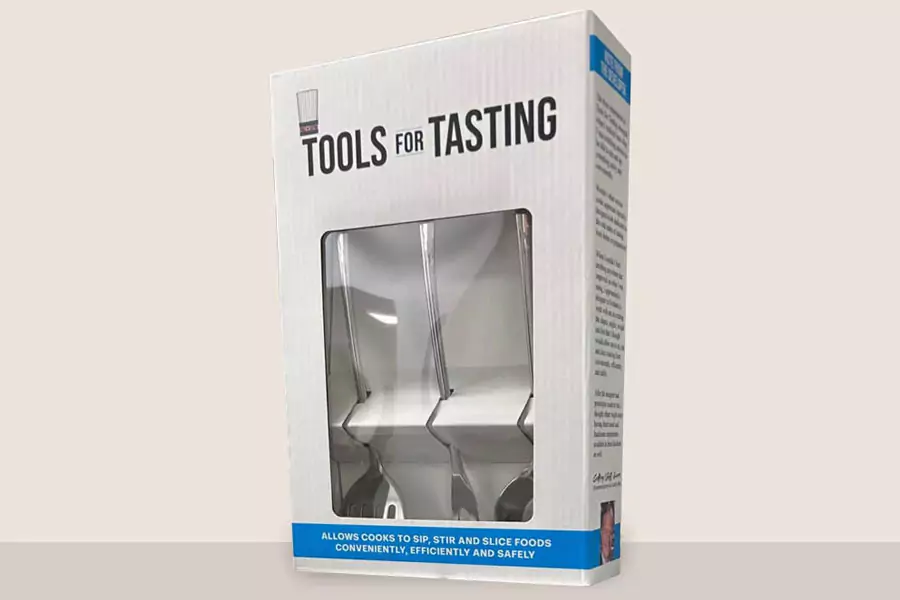
Small tools, big impact.
Here’s how a simple frustration at the stove became a trio of utensils engineered to help cooks taste smarter, move faster, and prepare new dishes with confidence.
Every idea starts with a problem. In our case, the problem was obvious: the spoons and forks we reached for while cooking were too small, clumsy, messy, or unsafe for quick tasting. So, we decided to solve it.
Tools for Tasting grew from one cook’s impatience with big, awkward utensils and from a simple question: what if tasting tools were designed specifically for the act of tasting, while the food is still in preparation? That spark is the brand’s origin, and it shapes every design choice and material selection.
What inspired the set? Practicality. Cooks consistently expressed their frustration with tasting wet wood, managing ladles, tilting heavy pots, and risking burns just to sample a dish or check doneness. In response, we developed utensils designed for efficiency—unique tools that allow you to easily take a clean sample, cut a small portion, or test a single strand of pasta, all without unnecessary hassle or risk. All this, without stopping the flow of cooking. In short, we aimed to keep your kitchen rhythm steady and to reduce the small interruptions that add up during service.
First, the Scoopasure tasting spoon. It lifts a clean, controlled portion of sauces, broths, and reductions so you can judge seasoning and texture accurately.
Next, the Kuhfork, a clever knife-and-fork hybrid that holds and slices a thin piece of meat for a true read on doneness.
Finally, a pasta tool called Noodula grips strands and tubes for quick al dente checks. Together, these utensils create a small, sensible toolkit for Tasting and testing during preparation.
We follow three simple rules when we design:
For us, these three rules are non-negotiable.
We selected highly polished stainless steel (304 grade) because it resists rust, endures frequent cleaning, and won’t pass on off-flavors to delicate sauces. Moreover, stainless steel is recyclable and long-lasting, which fits our small commitment to responsible product design. We also pay attention to finishing: edges are smoothed except where intentional sharpness is useful, like the cutting edge on the Kuhfork’s left tine. That balance minimizes risk to cookware while providing the control cooks need.
Look at the Scoopasure and you’ll see flattened sides and a generous thumb grip. These details matter when you’re balancing a spoon and a pan. Pick up the Kuhfork and you’ll notice its weight and balance; those traits let you take a single, clean slice without tearing. Importantly, these are not delicate display pieces: they are crafted to be used, to be visible on the counter, and to become part of your cooking rhythm. In other words, we design for repeated, real use.
Early adopters told us what worked and what didn’t. For instance, customers praised the balance and feel of the Kuhfork and said the tools were stylish enough to put on a buffet yet fully functional for everyday prep. Because of that feedback, we refined handles, adjusted edge radiuses, and confirmed dishwasher tolerance. Testimonials keep us honest; they also remind us why we started this project in the first place.
First, they reduce guesswork. A neat sample from the Scoopasure tells you whether the sauce needs acid, salt, or time, and it tells you quickly. Second, they speed the workflow; you taste, decide, and return to the pan instead of stalling to hunt down utensils. Third, they protect hands and wrists. Their long handles and balanced weight mean fewer burns and less fatigue. Consequently, you taste it more often. That simple behavioral shift (tasting more frequently) improves results dramatically.
We recommend rinsing promptly and using the dishwasher for convenience. However, occasional hand polishing keeps the finish bright. Because stainless steel endures, these tools avoid the short life span of cheap plastics. In fact, part of the choice to use stainless steel is environmental: it’s widely recyclable and stands up to repeated use, which reduces replacement waste over time.
These small acts change outcomes in tangible ways. They save time, limit waste, and keep dinner on track.
One of the original designers told us she sketched the first Spoon one evening after ruining a sauce by over-tilting a pan. She imagined a tool that let her taste without spilling or stealing half the sauce. That moment of annoyance led to dozens of prototypes and, finally, the streamlined Scoopasure. Stories like that live inside the metal: they remind us that design is problem-solving, day after day.
If you want utensils designed for precision, comfort, and durability, explore the Tools for Tasting collection. Check the Scoopasure, Kuhfork, and Noodula; choose one, or buy the set and put them where you can see them: next to the stove. Visit Tools for Tasting to preview the trio and read real customer experiences. Taste with purpose. Cook with confidence.